2020 NISSAN 370Z ECO mode
[x] Cancel search: ECO modePage 3 of 455

of the vehicle.
. ALWAYS review this Owner’s Man-
ual for important safety informa-
tion.
MODIFICATION OF YOUR VEHI-
CLE
This vehicle should not be modified.
Modification could affect its perfor-
mance, safety or durability, and may
even violate governmental regula-
tions. In addition, damage or perfor-
mance problems resulting from
modification will not be covered under
the NISSAN warranties.
WARNING
Installing an aftermarket On-Board
Diagnostic (OBD) plug-in device that
uses the port during normal driving,
for example remote insurance com-
pany monitoring, remote vehicle di-
agnostics, telematics or engine
reprogramming, may cause interfer-
ence or damage to vehicle systems.
We do not recommend or endorse
the use of any aftermarket OBD
plug-in devices, unless specifically approved by NISSAN. The vehicle
warranty may not cover damage
caused by any aftermarket plug-in
device.
WHEN READING THE MANUAL
This manual includes information for all
features and equipment available on
this model. Features and equipment in
your vehicle may vary depending on
model, trim level, options selected, or-
der, date of production, region or avail-
ability. Therefore, you may find
information about features or equip-
ment that are not included or installed
on your vehicle.
All information, specifications and illustra-
tions in this manual are those in effect at
the time of printing. NISSAN reserves the
right to change specifications, perfor-
mance, design or component suppliers
without notice and without obligation.
From time to time, NISSAN may update
or revise this manual to provide Owners
with the most accurate information cur-
rently available. Please carefully read and
retain with this manual all revision up-
dates sent to you by NISSAN to ensure
you have access to accurate and up-to-
date information regarding your vehicle.
Current versions of vehicle Owner’s Man-
uals and any updates can also be found inthe Owner section of the NISSAN website
at https://owners.nissanusa.com/now-
ners/navigation/manualsGuide. If you
have questions concerning any informa-
tion in your Owner’s Manual, contact
NISSAN Consumer Affairs. See the NISSAN
CUSTOMER CARE PROGRAM page in this
Owner’s Manual for contact information.
IMPORTANT INFORMATION ABOUT
THIS MANUAL
You will see various symbols in this
manual. They are used in the following
ways:
WARNING
This is used to indicate the presence
of a hazard that could cause death or
serious personal injury. To avoid or
reduce the risk, the procedures must
be followed precisely.
CAUTION
This is used to indicate the presence
of a hazard that could cause minor
or moderate personal injury or da-
mage to your vehicle. To avoid or
reduce the risk, the procedures must
Page 16 of 455
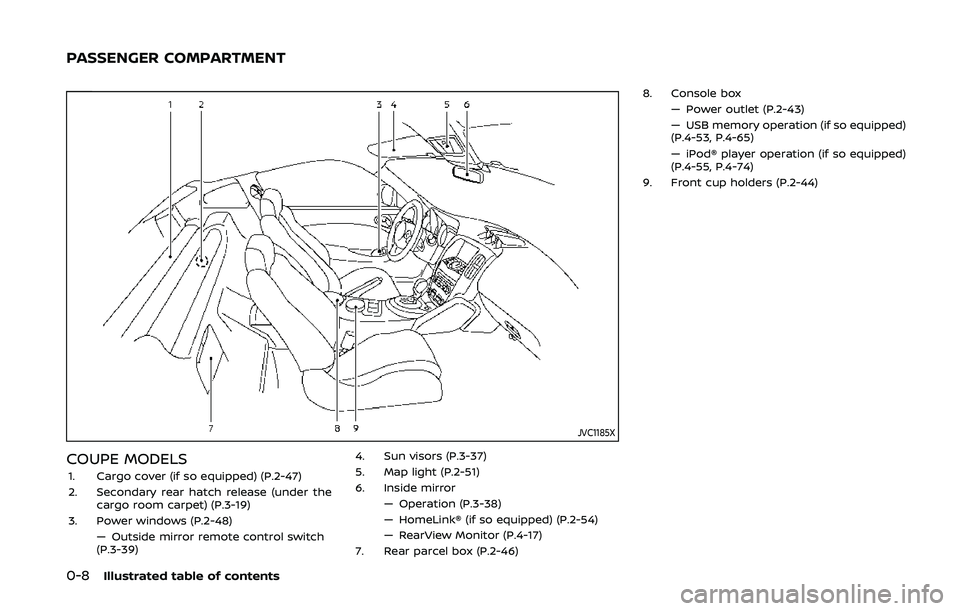
0-8Illustrated table of contents
JVC1185X
COUPE MODELS1. Cargo cover (if so equipped) (P.2-47)
2. Secondary rear hatch release (under thecargo room carpet) (P.3-19)
3. Power windows (P.2-48) — Outside mirror remote control switch
(P.3-39) 4. Sun visors (P.3-37)
5. Map light (P.2-51)
6. Inside mirror
— Operation (P.3-38)
— HomeLink® (if so equipped) (P.2-54)
— RearView Monitor (P.4-17)
7. Rear parcel box (P.2-46) 8. Console box
— Power outlet (P.2-43)
— USB memory operation (if so equipped)
(P.4-53, P.4-65)
— iPod® player operation (if so equipped)
(P.4-55, P.4-74)
9. Front cup holders (P.2-44)
PASSENGER COMPARTMENT
Page 17 of 455
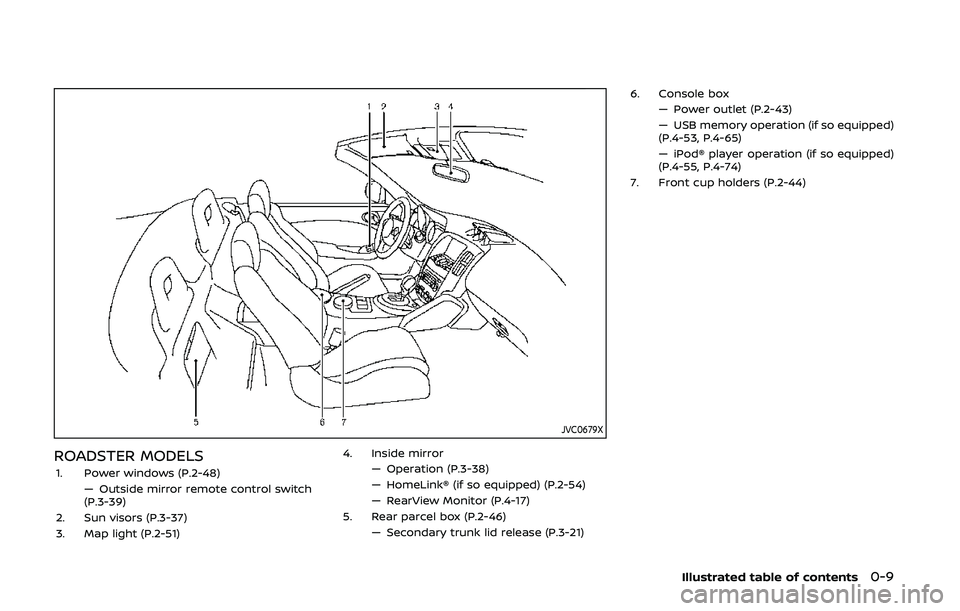
JVC0679X
ROADSTER MODELS1. Power windows (P.2-48)— Outside mirror remote control switch
(P.3-39)
2. Sun visors (P.3-37)
3. Map light (P.2-51) 4. Inside mirror
— Operation (P.3-38)
— HomeLink® (if so equipped) (P.2-54)
— RearView Monitor (P.4-17)
5. Rear parcel box (P.2-46) — Secondary trunk lid release (P.3-21) 6. Console box
— Power outlet (P.2-43)
— USB memory operation (if so equipped)
(P.4-53, P.4-65)
— iPod® player operation (if so equipped)
(P.4-55, P.4-74)
7. Front cup holders (P.2-44)
Illustrated table of contents0-9
Page 35 of 455
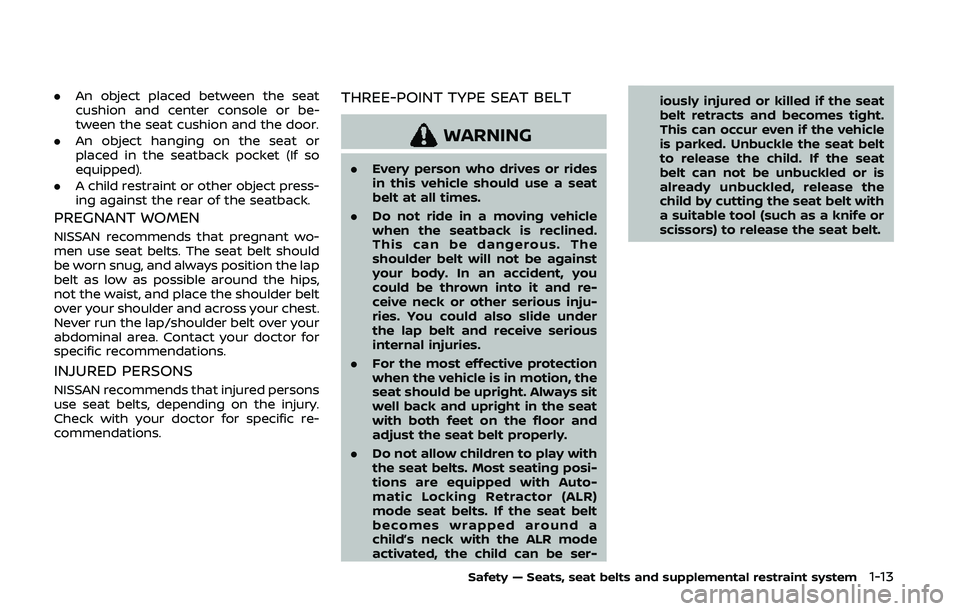
.An object placed between the seat
cushion and center console or be-
tween the seat cushion and the door.
. An object hanging on the seat or
placed in the seatback pocket (If so
equipped).
. A child restraint or other object press-
ing against the rear of the seatback.
PREGNANT WOMEN
NISSAN recommends that pregnant wo-
men use seat belts. The seat belt should
be worn snug, and always position the lap
belt as low as possible around the hips,
not the waist, and place the shoulder belt
over your shoulder and across your chest.
Never run the lap/shoulder belt over your
abdominal area. Contact your doctor for
specific recommendations.
INJURED PERSONS
NISSAN recommends that injured persons
use seat belts, depending on the injury.
Check with your doctor for specific re-
commendations.
THREE-POINT TYPE SEAT BELT
WARNING
.Every person who drives or rides
in this vehicle should use a seat
belt at all times.
. Do not ride in a moving vehicle
when the seatback is reclined.
This can be dangerous. The
shoulder belt will not be against
your body. In an accident, you
could be thrown into it and re-
ceive neck or other serious inju-
ries. You could also slide under
the lap belt and receive serious
internal injuries.
. For the most effective protection
when the vehicle is in motion, the
seat should be upright. Always sit
well back and upright in the seat
with both feet on the floor and
adjust the seat belt properly.
. Do not allow children to play with
the seat belts. Most seating posi-
tions are equipped with Auto-
matic Locking Retractor (ALR)
mode seat belts. If the seat belt
becomes wrapped around a
child’s neck with the ALR mode
activated, the child can be ser- iously injured or killed if the seat
belt retracts and becomes tight.
This can occur even if the vehicle
is parked. Unbuckle the seat belt
to release the child. If the seat
belt can not be unbuckled or is
already unbuckled, release the
child by cutting the seat belt with
a suitable tool (such as a knife or
scissors) to release the seat belt.
Safety — Seats, seat belts and supplemental restraint system1-13
Page 37 of 455
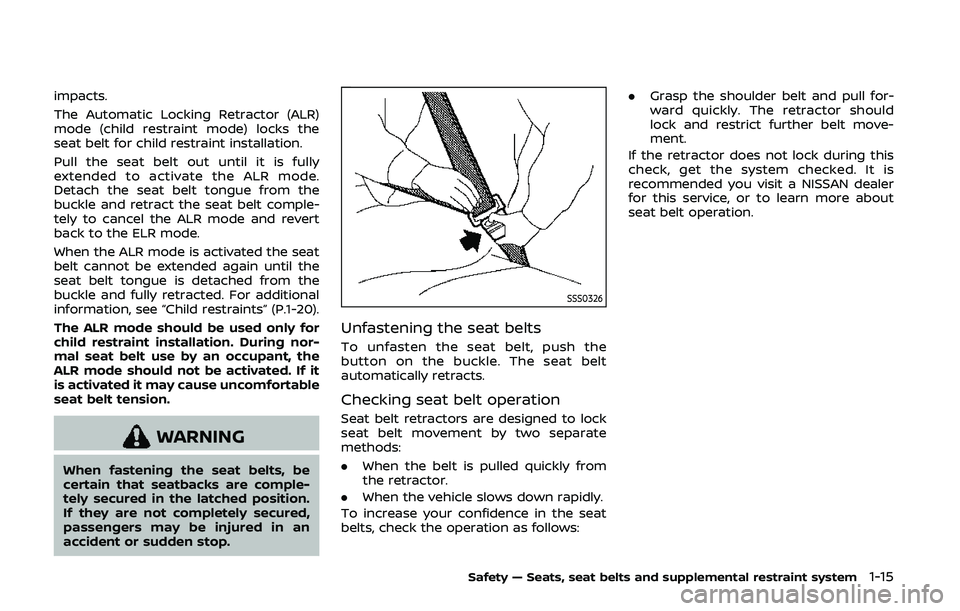
impacts.
The Automatic Locking Retractor (ALR)
mode (child restraint mode) locks the
seat belt for child restraint installation.
Pull the seat belt out until it is fully
extended to activate the ALR mode.
Detach the seat belt tongue from the
buckle and retract the seat belt comple-
tely to cancel the ALR mode and revert
back to the ELR mode.
When the ALR mode is activated the seat
belt cannot be extended again until the
seat belt tongue is detached from the
buckle and fully retracted. For additional
information, see “Child restraints” (P.1-20).
The ALR mode should be used only for
child restraint installation. During nor-
mal seat belt use by an occupant, the
ALR mode should not be activated. If it
is activated it may cause uncomfortable
seat belt tension.
WARNING
When fastening the seat belts, be
certain that seatbacks are comple-
tely secured in the latched position.
If they are not completely secured,
passengers may be injured in an
accident or sudden stop.
SSS0326
Unfastening the seat belts
To unfasten the seat belt, push the
button on the buckle. The seat belt
automatically retracts.
Checking seat belt operation
Seat belt retractors are designed to lock
seat belt movement by two separate
methods:
.When the belt is pulled quickly from
the retractor.
. When the vehicle slows down rapidly.
To increase your confidence in the seat
belts, check the operation as follows: .
Grasp the shoulder belt and pull for-
ward quickly. The retractor should
lock and restrict further belt move-
ment.
If the retractor does not lock during this
check, get the system checked. It is
recommended you visit a NISSAN dealer
for this service, or to learn more about
seat belt operation.
Safety — Seats, seat belts and supplemental restraint system1-15
Page 38 of 455
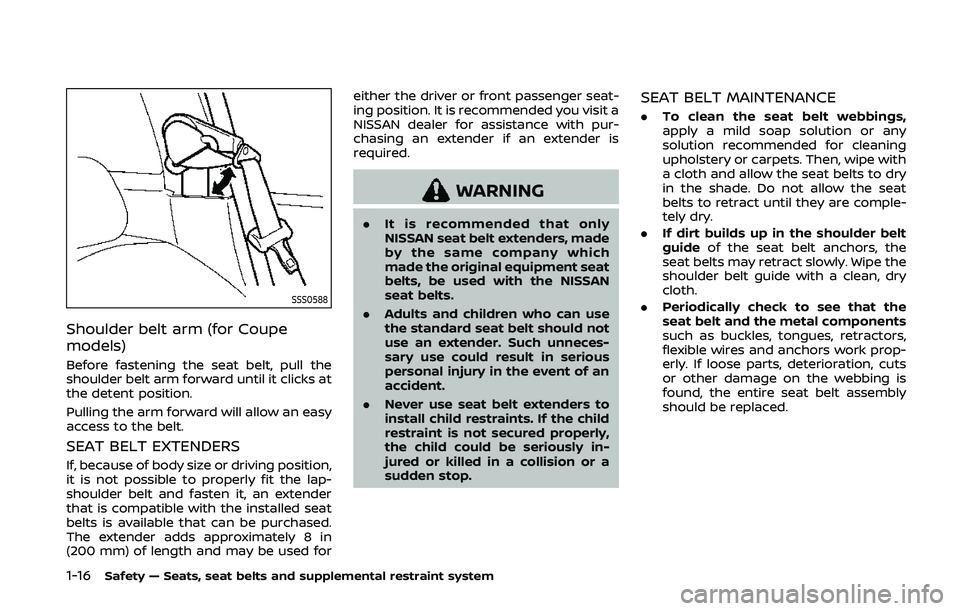
1-16Safety — Seats, seat belts and supplemental restraint system
SSS0588
Shoulder belt arm (for Coupe
models)
Before fastening the seat belt, pull the
shoulder belt arm forward until it clicks at
the detent position.
Pulling the arm forward will allow an easy
access to the belt.
SEAT BELT EXTENDERS
If, because of body size or driving position,
it is not possible to properly fit the lap-
shoulder belt and fasten it, an extender
that is compatible with the installed seat
belts is available that can be purchased.
The extender adds approximately 8 in
(200 mm) of length and may be used foreither the driver or front passenger seat-
ing position. It is recommended you visit a
NISSAN dealer for assistance with pur-
chasing an extender if an extender is
required.
WARNING
.
It is recommended that only
NISSAN seat belt extenders, made
by the same company which
made the original equipment seat
belts, be used with the NISSAN
seat belts.
. Adults and children who can use
the standard seat belt should not
use an extender. Such unneces-
sary use could result in serious
personal injury in the event of an
accident.
. Never use seat belt extenders to
install child restraints. If the child
restraint is not secured properly,
the child could be seriously in-
jured or killed in a collision or a
sudden stop.
SEAT BELT MAINTENANCE
. To clean the seat belt webbings,
apply a mild soap solution or any
solution recommended for cleaning
upholstery or carpets. Then, wipe with
a cloth and allow the seat belts to dry
in the shade. Do not allow the seat
belts to retract until they are comple-
tely dry.
. If dirt builds up in the shoulder belt
guide of the seat belt anchors, the
seat belts may retract slowly. Wipe the
shoulder belt guide with a clean, dry
cloth.
. Periodically check to see that the
seat belt and the metal components
such as buckles, tongues, retractors,
flexible wires and anchors work prop-
erly. If loose parts, deterioration, cuts
or other damage on the webbing is
found, the entire seat belt assembly
should be replaced.
Page 39 of 455
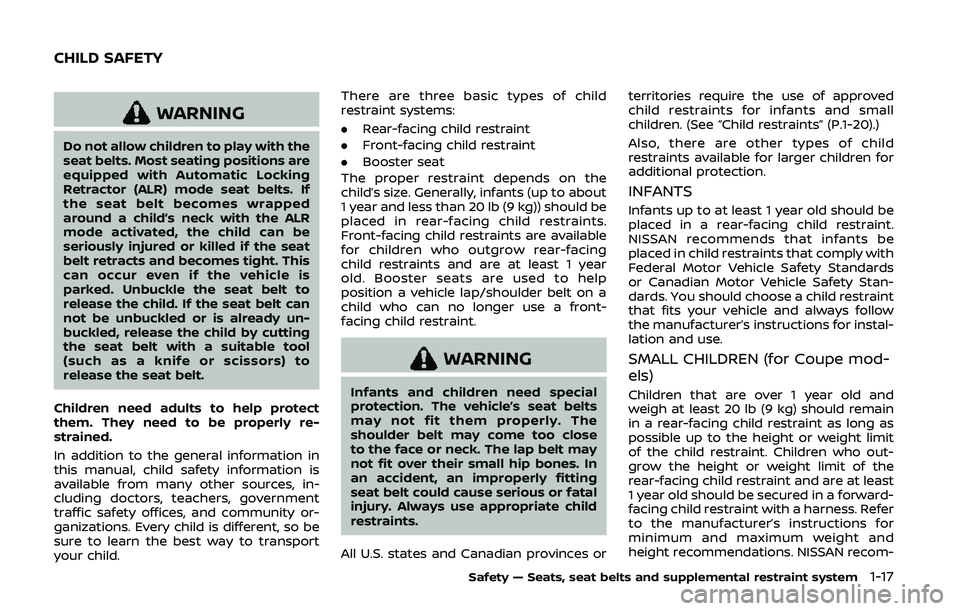
WARNING
Do not allow children to play with the
seat belts. Most seating positions are
equipped with Automatic Locking
Retractor (ALR) mode seat belts. If
the seat belt becomes wrapped
around a child’s neck with the ALR
mode activated, the child can be
seriously injured or killed if the seat
belt retracts and becomes tight. This
can occur even if the vehicle is
parked. Unbuckle the seat belt to
release the child. If the seat belt can
not be unbuckled or is already un-
buckled, release the child by cutting
the seat belt with a suitable tool
(such as a knife or scissors) to
release the seat belt.
Children need adults to help protect
them. They need to be properly re-
strained.
In addition to the general information in
this manual, child safety information is
available from many other sources, in-
cluding doctors, teachers, government
traffic safety offices, and community or-
ganizations. Every child is different, so be
sure to learn the best way to transport
your child. There are three basic types of child
restraint systems:
.
Rear-facing child restraint
. Front-facing child restraint
. Booster seat
The proper restraint depends on the
child’s size. Generally, infants (up to about
1 year and less than 20 lb (9 kg)) should be
placed in rear-facing child restraints.
Front-facing child restraints are available
for children who outgrow rear-facing
child restraints and are at least 1 year
old. Booster seats are used to help
position a vehicle lap/shoulder belt on a
child who can no longer use a front-
facing child restraint.
WARNING
Infants and children need special
protection. The vehicle’s seat belts
may not fit them properly. The
shoulder belt may come too close
to the face or neck. The lap belt may
not fit over their small hip bones. In
an accident, an improperly fitting
seat belt could cause serious or fatal
injury. Always use appropriate child
restraints.
All U.S. states and Canadian provinces or territories require the use of approved
child restraints for infants and small
children. (See “Child restraints” (P.1-20).)
Also, there are other types of child
restraints available for larger children for
additional protection.
INFANTS
Infants up to at least 1 year old should be
placed in a rear-facing child restraint.
NISSAN recommends that infants be
placed in child restraints that comply with
Federal Motor Vehicle Safety Standards
or Canadian Motor Vehicle Safety Stan-
dards. You should choose a child restraint
that fits your vehicle and always follow
the manufacturer’s instructions for instal-
lation and use.
SMALL CHILDREN (for Coupe mod-
els)
Children that are over 1 year old and
weigh at least 20 lb (9 kg) should remain
in a rear-facing child restraint as long as
possible up to the height or weight limit
of the child restraint. Children who out-
grow the height or weight limit of the
rear-facing child restraint and are at least
1 year old should be secured in a forward-
facing child restraint with a harness. Refer
to the manufacturer’s instructions for
minimum and maximum weight and
height recommendations. NISSAN recom-
Safety — Seats, seat belts and supplemental restraint system1-17
CHILD SAFETY
Page 43 of 455
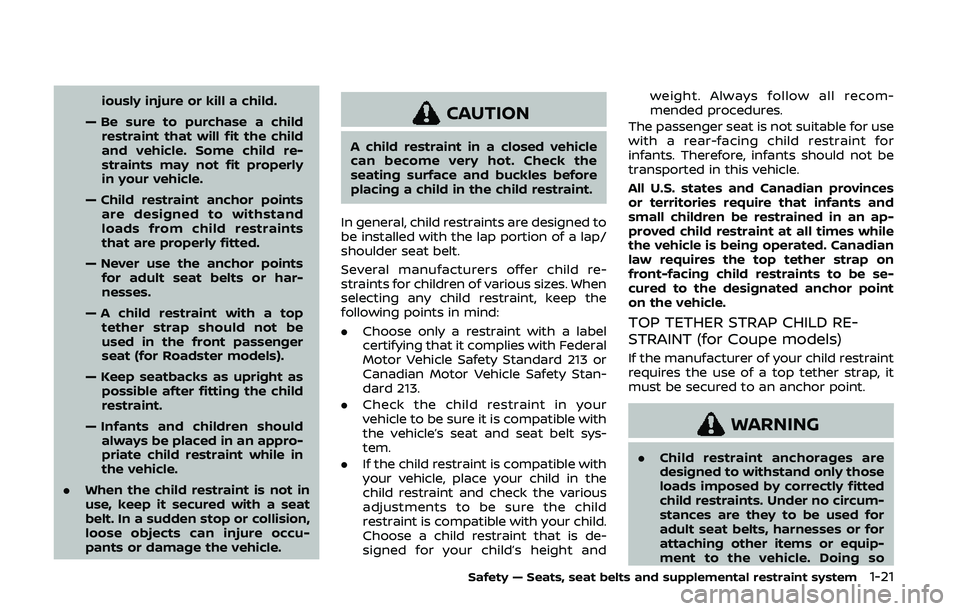
iously injure or kill a child.
— Be sure to purchase a child restraint that will fit the child
and vehicle. Some child re-
straints may not fit properly
in your vehicle.
— Child restraint anchor points are designed to withstand
loads from child restraints
that are properly fitted.
— Never use the anchor points for adult seat belts or har-
nesses.
— A child restraint with a top tether strap should not be
used in the front passenger
seat (for Roadster models).
— Keep seatbacks as upright as possible after fitting the child
restraint.
— Infants and children should always be placed in an appro-
priate child restraint while in
the vehicle.
. When the child restraint is not in
use, keep it secured with a seat
belt. In a sudden stop or collision,
loose objects can injure occu-
pants or damage the vehicle.CAUTION
A child restraint in a closed vehicle
can become very hot. Check the
seating surface and buckles before
placing a child in the child restraint.
In general, child restraints are designed to
be installed with the lap portion of a lap/
shoulder seat belt.
Several manufacturers offer child re-
straints for children of various sizes. When
selecting any child restraint, keep the
following points in mind:
. Choose only a restraint with a label
certifying that it complies with Federal
Motor Vehicle Safety Standard 213 or
Canadian Motor Vehicle Safety Stan-
dard 213.
. Check the child restraint in your
vehicle to be sure it is compatible with
the vehicle’s seat and seat belt sys-
tem.
. If the child restraint is compatible with
your vehicle, place your child in the
child restraint and check the various
adjustments to be sure the child
restraint is compatible with your child.
Choose a child restraint that is de-
signed for your child’s height and weight. Always follow all recom-
mended procedures.
The passenger seat is not suitable for use
with a rear-facing child restraint for
infants. Therefore, infants should not be
transported in this vehicle.
All U.S. states and Canadian provinces
or territories require that infants and
small children be restrained in an ap-
proved child restraint at all times while
the vehicle is being operated. Canadian
law requires the top tether strap on
front-facing child restraints to be se-
cured to the designated anchor point
on the vehicle.
TOP TETHER STRAP CHILD RE-
STRAINT (for Coupe models)
If the manufacturer of your child restraint
requires the use of a top tether strap, it
must be secured to an anchor point.
WARNING
. Child restraint anchorages are
designed to withstand only those
loads imposed by correctly fitted
child restraints. Under no circum-
stances are they to be used for
adult seat belts, harnesses or for
attaching other items or equip-
ment to the vehicle. Doing so
Safety — Seats, seat belts and supplemental restraint system1-21